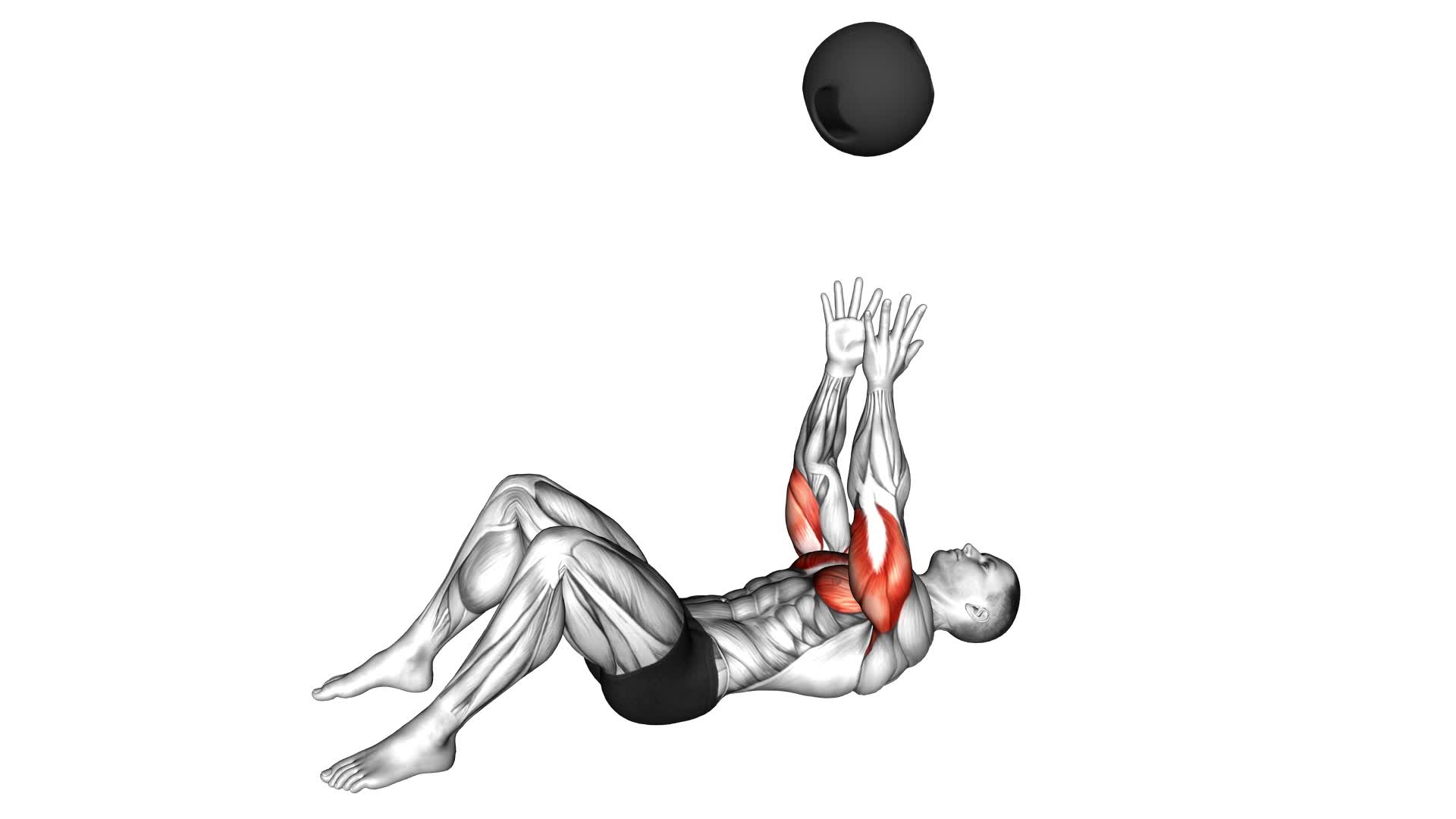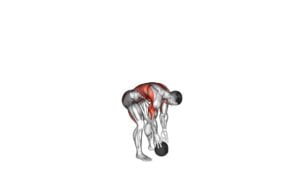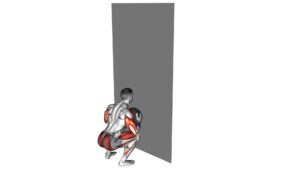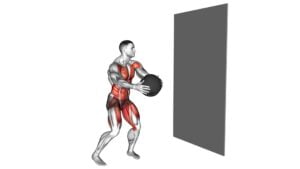Medicine Ball Supine Chest Throw – Video Exercise Guide & Tips

Looking to strengthen your chest and core? Check out this video exercise guide on the medicine ball supine chest throw. This explosive exercise targets your upper body muscles and can help improve power and coordination.
Watch This Exercise Video
In just a few minutes, you'll learn the proper form and technique, as well as common mistakes to avoid.
Plus, we'll share tips to maximize the effectiveness of this exercise and variations to challenge yourself further.
Let's get started!
Key Takeaways
- The medicine ball supine chest throw targets the chest, shoulders, and triceps muscles, improving upper body strength and power.
- It enhances coordination, muscular endurance, core stability, and balance.
- Using appropriate equipment and ensuring safety measures are taken is important for the effectiveness of the exercise.
- Inexpensive alternatives such as DIY fitness equipment or using resistance bands or dumbbells can be used as alternatives to expensive equipment.
Benefits of the Medicine Ball Supine Chest Throw
The Medicine Ball Supine Chest Throw offers a range of benefits for improving upper body strength and power. This exercise, performed lying on your back with a medicine ball, targets the muscles in your chest, shoulders, and triceps. One of the advantages of the Supine Chest Throw is that it allows you to generate explosive power and force through your upper body, which can enhance your performance in activities that require throwing or pushing movements. By engaging these muscles in a dynamic and controlled manner, you can develop greater strength and muscular endurance.
Furthermore, the Supine Chest Throw can also improve your core stability and balance, as you need to engage your abdominal muscles to maintain a stable position on the ground while performing the exercise. This can translate into improved functional movements and better overall body control. Additionally, incorporating the Supine Chest Throw into your training routine can lead to increased muscle definition in your chest and shoulders, giving you a more sculpted and toned upper body.
In terms of results, regularly performing the Medicine Ball Supine Chest Throw can lead to increased upper body strength, power, and muscular endurance. You may find that you're able to lift heavier weights or perform more repetitions in other upper body exercises, such as bench press or push-ups. The explosive nature of this exercise can also enhance your athletic performance, enabling you to throw or push objects with greater force and efficiency.
Equipment Needed for the Exercise
To perform the Medicine Ball Supine Chest Throw, you'll need a medicine ball. This exercise requires the use of proper equipment to ensure safety and effectiveness.
If you don't have access to a medicine ball, there are alternative options you can use to achieve similar results without the need for expensive equipment.
Required Equipment for Exercise
You will need a medicine ball for the Medicine Ball Supine Chest Throw exercise. Here are some cost-effective equipment options for this exercise:
- Medicine ball: Choose a weight that challenges you but allows you to maintain proper form and control throughout the exercise. A 4- to 8-pound medicine ball is a good starting point for beginners.
- Exercise mat: Use a thick exercise mat to provide cushioning and support for your spine and lower back during the exercise.
- Optional: Resistance bands or dumbbells can be used as alternative exercises to the medicine ball. They offer similar benefits and can be more affordable options.
Having the right equipment is important for performing the Medicine Ball Supine Chest Throw exercise correctly and safely. Now, let's move on to the next section to understand the importance of proper equipment in your workout routine.
Importance of Proper Equipment
Proper equipment is essential for safely and effectively performing the Medicine Ball Supine Chest Throw exercise. When it comes to this exercise, affordable equipment options are available that can meet your needs.
It's important to consider safety when choosing equipment for this exercise. Look for a medicine ball that's the appropriate weight for your fitness level and strength. Make sure the ball is durable and can withstand the force of your throws. Additionally, consider using a mat or padding to protect your back and spine during the exercise.
Always inspect the equipment before each use to ensure it's in good condition and free of any defects. By using the right equipment, you can perform the Medicine Ball Supine Chest Throw exercise safely and effectively.
Alternatives to Expensive Equipment
When selecting equipment for the Medicine Ball Supine Chest Throw exercise, it's important to consider cost-effective alternatives that still meet your needs. Here are three budget-friendly workout alternatives that you can try:
- DIY fitness equipment: Instead of purchasing an expensive medicine ball, you can create your own by filling an old basketball or soccer ball with sand or rice. This homemade medicine ball will provide the same resistance and allow you to perform the exercise effectively.
- Resistance bands: These versatile bands are affordable and can be used for a variety of exercises, including the supine chest throw. Attach the band to a sturdy anchor point and use it to mimic the throwing motion. The resistance will challenge your muscles and help you achieve the desired results.
- Dumbbells: If you already have a set of dumbbells, they can serve as a great alternative to a medicine ball. Hold the dumbbells with an overhand grip and perform the chest throw motion. Adjust the weight of the dumbbells to match your fitness level and gradually increase it as you progress.
Step-by-Step Guide to Proper Form and Technique
To perform the Medicine Ball Supine Chest Throw with proper form and technique, start by selecting a suitable weight for your fitness level. The proper technique is crucial for maximizing the benefits of this exercise and ensuring safety. By following these steps, you can achieve optimal results.
- Lie on a flat bench with your feet flat on the ground and your knees bent.
- Hold the medicine ball with both hands, keeping your elbows bent and close to your sides.
- Engage your core by tightening your abdominal muscles.
- Inhale deeply, then exhale forcefully as you push the ball upwards towards the ceiling.
- Release the ball at the top of the movement, allowing it to travel towards your partner or rebound off a wall.
- Catch the ball or allow it to bounce back towards you, and repeat the movement for the desired number of repetitions.
Proper form and technique are essential for this exercise because they help engage the muscles in your chest, shoulders, and arms effectively. Additionally, the Medicine Ball Supine Chest Throw requires a stable core to generate power and control the movement. By strengthening your core, you can improve your overall stability and prevent injury during this exercise. Remember to start with a weight that challenges you but still allows you to maintain proper form throughout the movement.
Common Mistakes to Avoid
When performing the medicine ball supine chest throw, it's important to avoid common mistakes that can hinder your progress and increase the risk of injury.
One common mistake to avoid is incorrect hand placement, as this can affect the trajectory and power of the throw.
Additionally, insufficient core engagement can lead to poor stability and reduced effectiveness of the exercise.
Incorrect Hand Placement
Make sure you place your hands correctly to avoid common mistakes during the Medicine Ball Supine Chest Throw exercise. Incorrect hand placement can lead to decreased power and potential injury. Here are some common errors to avoid:
- Placing your hands too close together: This reduces your ability to generate force and can strain your wrists and elbows. Keep your hands shoulder-width apart for optimal power and stability.
- Gripping the ball too tightly: A tight grip restricts the fluidity of your movement and limits your power. Instead, hold the ball with a firm yet relaxed grip to maximize your throwing potential.
- Failing to align your hands with your chest: If your hands aren't in line with your chest, you'll lose power and accuracy in your throw. Make sure your hands are directly in front of your chest to generate maximum force.
Insufficient Core Engagement
Engage your core properly to avoid common mistakes during the Medicine Ball Supine Chest Throw exercise. Core stability is crucial for this exercise, as it helps generate power and control during the movement.
One common mistake is insufficient core engagement, which can lead to poor form and reduced effectiveness of the exercise. To ensure proper core engagement, focus on bracing your abdominal muscles and maintaining a stable spine throughout the movement. Avoid arching your back or letting your core collapse.
If you find it challenging to engage your core, try modifying the exercise by using a lighter medicine ball or reducing the range of motion.
Tips to Maximize the Effectiveness of the Exercise
To maximize the effectiveness of the exercise, focus on maintaining a stable core throughout the movement. This won't only help you generate more power but also protect your lower back from strain.
Here are some tips to help you maximize the results of the medicine ball supine chest throw:
- Proper Breathing Techniques: Take a deep breath in as you lower the medicine ball towards your chest. This will engage your core and create tension in your muscles. As you explosively push the ball upwards, exhale forcefully. This will help you generate more power and maintain stability throughout the movement.
- Use the Right Weight: Choose a medicine ball that allows you to perform the exercise with proper form and control. If the ball is too light, you won't be able to generate enough power. On the other hand, if the ball is too heavy, you may compromise your form and risk injury. Start with a moderate weight and gradually increase it as you get stronger.
- Focus on Explosiveness: The medicine ball supine chest throw is a power-based exercise, so it's important to focus on explosive movements. Imagine yourself throwing the ball as far as possible, using all your strength. This will help you recruit more muscle fibers and maximize your power output.
Variations and Progressions to Challenge Yourself Further
To further challenge yourself, try incorporating different variations and progressions into your medicine ball supine chest throw routine. These variations and progressions can help you target specific muscle groups, increase the difficulty level, and enhance overall strength and power.
One variation you can try is the single-arm medicine ball supine chest throw. Instead of using both arms, hold the medicine ball with one hand and perform the chest throw. This variation won't only challenge your chest muscles but also engage your core and improve stability.
Another variation is the staggered stance medicine ball supine chest throw. Instead of lying flat on your back, assume a staggered stance with one foot forward and one foot back. As you perform the chest throw, the staggered stance will challenge your balance and activate different muscle groups.
To progress the exercise further, you can increase the weight of the medicine ball or perform the throw on an unstable surface, such as a Bosu ball or a stability ball. These progressions will require more strength and stability, pushing your muscles to work harder.
Incorporating these variations and progressions into your medicine ball supine chest throw routine will add variety to your workouts and help you continually challenge yourself. Remember to start with lighter weights and gradually increase the difficulty level as you become more comfortable and stronger.
Frequently Asked Questions
Can the Medicine Ball Supine Chest Throw Be Done Without a Partner?
Yes, you can definitely do the medicine ball supine chest throw without a partner. There are solo variations of this exercise that you can try.
If you don't have a medicine ball, you can also do alternative exercises that target similar muscles.
It's important to maintain proper form and start with a weight that's appropriate for your fitness level.
Remember to consult a professional if you have any concerns or questions.
Can the Exercise Be Modified for Individuals With Lower Back Pain?
If you're dealing with lower back pain, it's important to modify exercises to avoid exacerbating your condition.
When it comes to the medicine ball supine chest throw, there are a few modifications you can make. Instead of throwing the ball, you can simply hold it and engage your core muscles by pressing it upwards.
Alternatively, you can try other exercises that target your chest muscles, such as the dumbbell chest press or push-ups on an incline surface.
How Many Sets and Repetitions Should Be Performed for Optimal Results?
To achieve optimal results, it's important to consider the number of sets and repetitions for the exercise. The number of sets and repetitions will vary depending on your fitness level and goals.
It's generally recommended to perform multiple sets with a moderate number of repetitions to challenge your muscles and promote growth. However, it's always a good idea to consult with a fitness professional or trainer to determine the best set and repetition range for your specific needs.
Additionally, there may be variations of the exercise that can be modified for individuals with lower back pain.
Is the Supine Chest Throw Suitable for Beginners or Individuals With Limited Upper Body Strength?
The supine chest throw can be challenging for beginners or those with limited upper body strength. However, there are modifications you can make to accommodate different fitness levels.
Start with a lighter medicine ball or use a softer object like a pillow. As you gain strength and confidence, you can progress by increasing the weight of the ball or using a harder surface.
Always prioritize safety and listen to your body to avoid injury.
Can the Exercise Be Incorporated Into a Full-Body Workout Routine?
Incorporating the medicine ball supine chest throw into a full-body workout routine has numerous benefits.
It helps to improve upper body strength, power, and explosiveness while engaging the core muscles.
This exercise targets the chest, shoulders, and triceps, promoting muscle growth and definition.
For advanced athletes, there are variations and progressions available to increase the challenge and intensity of the exercise.
Conclusion
In conclusion, the medicine ball supine chest throw is a beneficial exercise for strengthening the chest muscles and improving upper body power.
It requires minimal equipment and can be easily incorporated into a workout routine.
By following the proper form and technique, avoiding common mistakes, and implementing variations and progressions, you can maximize the effectiveness of this exercise.
So, give it a try and challenge yourself to take your fitness to the next level.

Author
Years ago, the spark of my life’s passion ignited in my mind the moment I stepped into the local gym for the first time. The inaugural bead of perspiration, the initial endeavor, the very first surge of endorphins, and a sense of pride that washed over me post-workout marked the beginning of my deep-seated interest in strength sports, fitness, and sports nutrition. This very curiosity blossomed rapidly into a profound fascination, propelling me to earn a Master’s degree in Physical Education from the Academy of Physical Education in Krakow, followed by a Sports Manager diploma from the Jagiellonian University. My journey of growth led me to gain more specialized qualifications, such as being a certified personal trainer with a focus on sports dietetics, a lifeguard, and an instructor for wellness and corrective gymnastics. Theoretical knowledge paired seamlessly with practical experience, reinforcing my belief that the transformation of individuals under my guidance was also a reflection of my personal growth. This belief holds true even today. Each day, I strive to push the boundaries and explore new realms. These realms gently elevate me to greater heights. The unique combination of passion for my field and the continuous quest for growth fuels my drive to break new ground.







